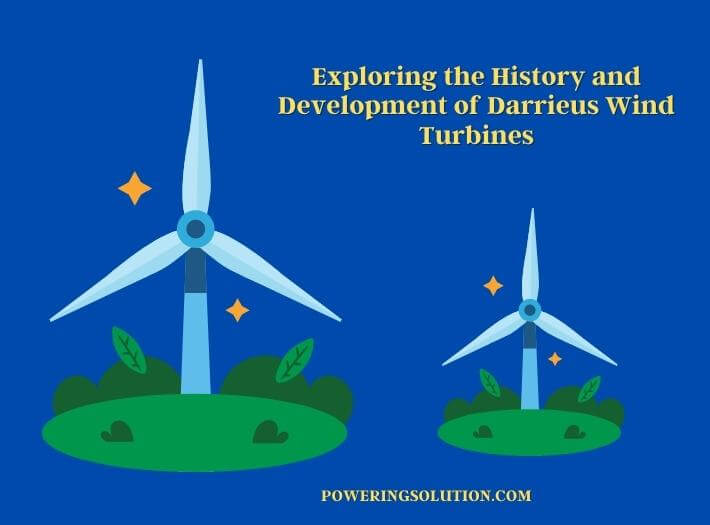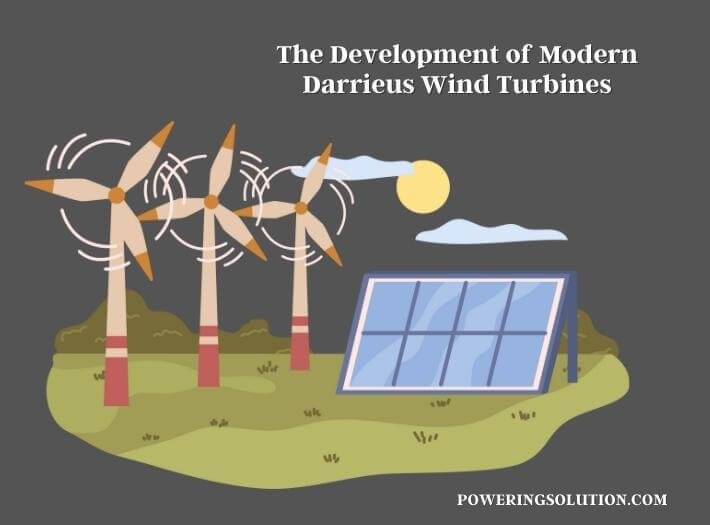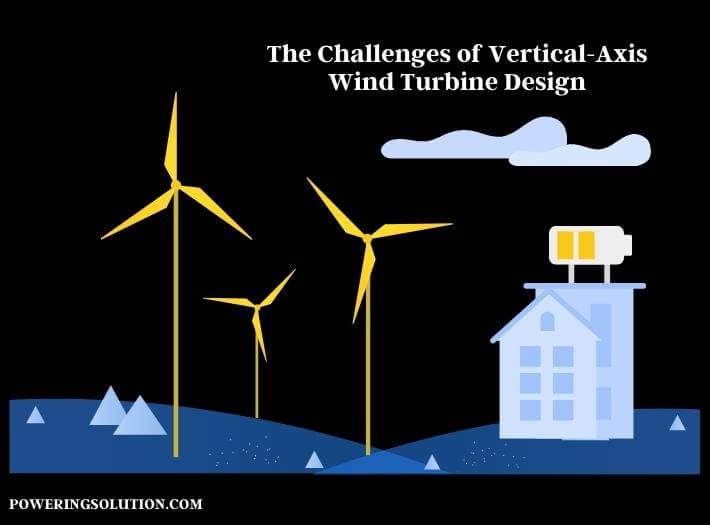Wind turbines have become an increasingly popular source of renewable energy in recent years, with many countries investing in these sustainable power systems as a way to reduce their carbon footprint and combat climate change. While most people are familiar with the modern horizontal-axis wind turbines that are commonly used today, there is another type of wind turbine that has a rich history and a unique design: the Darrieus wind turbine.

Named after its inventor, French engineer Georges Darrieus, this vertical-axis wind turbine has a distinctive helical blade design that sets it apart from other wind turbines. Among the various types of wind turbines, horizontal axis wind turbines (HAWTs) are the most common work for generating electricity.
The Early Days of Darrieus Wind Turbines
The Darrieus wind turbine, also known as the eggbeater wind turbine, is a type of vertical-axis wind turbine that was invented by French engineer Georges Darrieus in the early 1930s. The design was originally intended for use as a water-pumping device, but it soon became clear that it had potential as a wind turbine.
The earliest known patent for a Darrieus wind turbine was filed by Darrieus in 1926, but it was not until the early 1930s that the first prototypes were built and tested. One of the earliest prototypes was installed at the Yport power station in France in 1931, where it was used to generate electricity for the first time.
Despite the initial success of the Yport prototype, Darrieus wind turbines did not gain widespread use until much later. One of the main reasons for this was the development of more efficient horizontal-axis wind turbines, which became the dominant design for wind turbines in the following decades.
Interest in Darrieus wind turbines was renewed in the 1970s when there was a growing interest in renewable energy sources due to the oil crisis. Researchers began to study the design and potential applications of Darrieus wind turbines, and several prototypes were built and tested.
The Development of Modern Darrieus Wind Turbines
In the decades since the 1970s, Darrieus wind turbines have continued to evolve and improve. Advances in materials and manufacturing techniques have made it possible to build larger and more efficient turbines, while improvements in control systems and grid integration have made them more practical for use in power generation.

One of the key challenges in the development of Darrieus wind turbines has been improving their efficiency. Compared to horizontal-axis wind turbines, Darrieus turbines tend to have lower efficiency due to factors such as drag, blade stall, and turbulence. However, researchers have developed a range of strategies to improve efficiency, such as adding flaps or spoilers to the blades, using variable-pitch blades, and optimizing the blade shape and angle.
Another challenge has been reducing the noise and vibration generated by Darrieus wind turbines. Because of their unique design, Darrieus turbines can produce more noise and vibration than horizontal-axis turbines, which can be a concern in urban or residential areas. Researchers have developed various noise-reduction strategies, such as adding noise-absorbing materials to the blades and tower, using quieter bearings and generators, and optimizing the turbine placement and orientation.
Darrieus wind turbines continue to be an important area of research and development in the field of renewable energy. They offer a number of potential advantages, such as their ability to operate in low-wind environments, their compact design, and their potential for integration into urban and residential settings. As the demand for clean energy continues to grow, Darrieus wind turbines may play an increasingly important role in the transition to a more sustainable energy future.
It’s important to know about designing Savonius turbines for maximum efficiency. Click here for details.
The Challenges of Vertical-Axis Wind Turbine Design
Vertical-axis wind turbines (VAWTs), such as the Darrieus wind turbine, face a number of unique challenges in their design and operation. Some of the key challenges include:

Lower Efficiency
Compared to horizontal-axis wind turbines (HAWTs), VAWTs tend to have lower efficiency due to factors such as drag, blade stall, and turbulence. This is partly because VAWTs operate in a more complex and turbulent airflow environment, which can lead to lower energy capture.
Increased Noise and Vibration
VAWTs can produce more noise and vibration than HAWTs due to their unique design, which can be a concern in urban or residential areas. This is because the blades of a VAWT pass through the tower, which can cause the tower to vibrate and generate noise.
Structural Challenges
The unique design of VAWTs can also pose structural challenges, particularly in terms of supporting the weight of the turbine and minimizing stress on the blades and tower. This can require the use of more advanced materials and structural designs.
Control and Stability
VAWTs can be more difficult to control and stabilize than HAWTs, particularly in high-wind conditions. This is because the design of VAWTs can lead to asymmetrical forces on the blades, which can affect the stability of the turbine.
Note It
There are a number of advantages to VAWTs that make them an attractive option for wind power generation. For example, VAWTs are generally more compact and can be mounted closer to the ground, making them well-suited for use in urban or residential areas. They can also operate in low-wind conditions and can be more cost effective to manufacture than HAWTs.
To address some of the challenges facing VAWTs, researchers are developing a range of strategies to improve their efficiency, reduce noise and vibration, and enhance their structural stability. For example, some researchers are exploring the use of active control systems to adjust the blade angles in real-time, while others are developing new materials and blade designs to reduce drag and turbulence. As these and other innovations continue to advance, the potential of VAWTs for wind power generation is likely to continue to grow.
Innovations in Darrieus Wind Turbine Technology
Over the years, there have been a number of innovations in Darrieus wind turbine technology that have helped to improve their efficiency and reliability. Some of the key innovations include:
Aerodynamic Design Improvements
Researchers have developed a range of new aerodynamic designs for Darrieus wind turbines that can help to improve their efficiency and reduce drag. For example, some designs incorporate curved blades or winglets to help reduce turbulence and improve energy capture.
Material Advancements
Advances in materials science have also played a role in improving Darrieu’s wind turbine technology. New lightweight materials such as carbon fiber composites and new manufacturing techniques have allowed for the development of stronger and more durable turbine components.
Improved Control Systems
Researchers have developed a range of new control systems for Darrieus wind turbines that can help to improve their stability and performance. For example, some systems use sensors and algorithms to adjust the blade angles in real time, optimizing energy capture and reducing loads on the turbine.
Hybrid Systems
Some researchers are exploring the potential of hybrid systems that combine Darrieus wind turbines with other renewable energy sources such as solar or hydropower. These systems can help to improve energy reliability and reduce costs by maximizing energy capture across different weather conditions.
Vertical-Axis Wind Turbine Farms
There has been a growing interest in developing vertical-axis wind turbine farms, which can allow for more efficient and cost-effective wind power generation. By clustering turbines together in arrays, it is possible to create more stable and predictable airflow patterns, reducing turbulence and improving energy capture.
As these and other innovations continue to advance, the potential of Darrieus wind turbines for renewable energy generation is likely to continue to grow. With their unique vertical-axis design, Darrieus turbines offer a number of advantages over traditional horizontal-axis turbines, making them an attractive option for wind power generation in a range of settings.
Do you have to know that Is Run-of-River Hydroelectricity Right for Your Community? Follow here to know this.
Potential Advantages and Limitations of Darrieus Wind Turbines
Darrieus wind turbines have a range of modern applications across a variety of industries. Some of the most common applications include:
Wind Power Generation
One of the primary applications of Darrieus wind turbines is for wind power generation. In particular, they are well-suited for use in urban or residential areas where space is limited and where horizontal-axis turbines may not be feasible. Darrieus turbines can be mounted on rooftops or in small arrays, making them a practical option for small-scale wind power generation.
Marine and Offshore Applications
Darrieus wind turbines are also well-suited for use in marine and offshore environments, where they can be used to power small boats or provide energy for offshore oil and gas rigs. Their compact size and vertical-axis design make them ideal for use in confined spaces or in areas where high winds are common.
Research and Development
Darrieus wind turbines are often used for research and development purposes, as they offer a unique platform for testing new materials, designs, and control systems. Researchers can use Darrieus turbines to study the aerodynamics of wind energy, optimize energy capture, and develop new technologies to improve wind power generation.
Hybrid Energy Systems
Darrieus wind turbines can also be used as part of hybrid energy systems, where they are combined with other renewable energy sources such as solar or hydropower. By combining different energy sources, it is possible to create more stable and reliable energy systems that can provide power in a range of weather conditions.
Education and Outreach
Darrieus wind turbines are also used in educational settings, where they offer a hands-on way for students to learn about renewable energy generation and the physics of wind power. They can also be used in public outreach and awareness campaigns to promote the benefits of renewable energy and encourage greater adoption of wind power generation.
Modern Applications of Darrieus Wind Turbines
Darrieus wind turbines offer a range of potential advantages and limitations that should be considered when evaluating their use in wind power generation. Some of the key advantages and limitations include:
Advantages
Compact Design:
Darrieus wind turbines have a compact vertical-axis design that makes them well-suited for use in urban or residential areas where space is limited.
Low Noise:
Compared to traditional horizontal-axis turbines, Darrieus turbines tend to produce less noise, making them a more attractive option for use in densely populated areas.
Low Wind Speed Operation:
Darrieus turbines are capable of operating in low wind speed conditions, which can help to improve energy capture and make them more practical for use in a wider range of settings.
Minimal Environmental Impact:
Darrieus turbines have a relatively low environmental impact, as they do not require large amounts of land or create significant noise or visual pollution.
Easy Maintenance: With their simple design and few moving parts, Darrieus turbines are relatively easy to maintain and can be less expensive to repair than other types of wind turbines.
Limitations
Starting Torque:
Darrieus turbines require a high starting torque to overcome inertia and begin rotating. This can limit their ability to start in low wind conditions or during sudden changes in wind speed.
Vibration:
Darrieus turbines can be prone to vibration, which can reduce their efficiency and lifespan. This can be addressed through careful design and the use of advanced control systems.
Complexity:
Compared to traditional horizontal-axis turbines, Darrieus turbines can be more complex to design and manufacture, requiring specialized expertise and advanced materials.
Limited Scaling:
Darrieus turbines can be more difficult to scale up than horizontal-axis turbines, making them less practical for large-scale wind power generation.
Wind Turbulence:
Darrieus turbines can be sensitive to wind turbulence and variations in wind speed, which can reduce their efficiency and increase wear and tear on the turbine components.
Darrieus wind turbines offer a unique and promising approach to wind power generation. While they do have some limitations and design challenges, ongoing advancements in materials science, aerodynamics, and control systems are likely to continue improving their efficiency and reliability, making them an increasingly attractive option for renewable energy generation in a range of settings.
Last Assumption
The history and development of Darrieus wind turbines have been marked by a series of innovative breakthroughs and design challenges. While the early designs faced issues with vibration and stability, ongoing advancements in materials science, aerodynamics, and control systems have enabled the development of more efficient and reliable turbines.
Darrieus wind turbines are increasingly being deployed in a wide range of applications, from urban and residential settings to offshore wind farms and remote power systems. With their compact design, low noise, and ability to operate in low wind speed conditions, they offer several advantages over traditional horizontal-axis turbines.
As research and development continue to improve their performance and reduce their cost, it is likely that they will play an increasingly important role in the transition to a more sustainable energy future.
